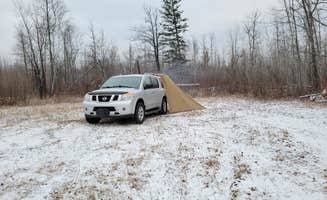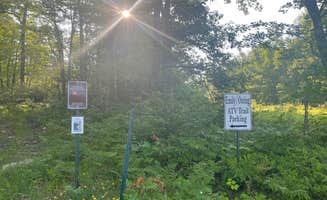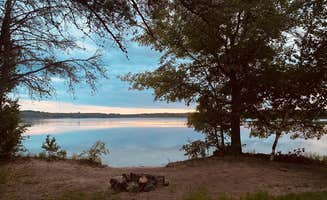Hill River State Forest offers primitive camping experiences on remote forest roads approximately 15 miles northeast of Turner, Minnesota. The terrain features a mix of aspen and pine forests interspersed with small lakes and wetlands. Seasonal changes significantly impact camping conditions, with spring often bringing muddy roads and fall offering cooler temperatures ideal for rustic camping experiences.
What to do
Fishing opportunities: At Mabel Lake State Dispersed, campers can enjoy fishing from shore or small watercraft. "What a gem! I was able to back to the water to have a gorgeous view from bed! It was so quiet last night, although the beaked neighbors get pretty chatty early," notes visitor Joni Z.
Wildlife observation: The remote forest setting provides excellent wildlife viewing opportunities. In Hill River State Forest, the secluded environment supports diverse wildlife. A camper reported, "There were a good amount of spots, and I seemed to be the only person. Was a good and secluded. I did hear some weird noises throughout the night, but all was well."
Stargazing: The lack of light pollution makes Turner area dispersed sites excellent for night sky viewing. At Dago Lake, one visitor described the conditions as "Pitch black at night," making it ideal for stargazing enthusiasts who bring proper equipment.
What campers like
Solitude and quiet: Many dispersed sites near Turner provide isolation from crowds and noise. A camper at Hill River State Forest remarked, "It's quiet and deep in," highlighting the peaceful atmosphere found in these remote locations.
Multiple site options: Some areas offer flexibility for group camping or finding the perfect spot. At Mabel Lake, one reviewer noted, "Large enough for multiple campers or a small group. There are four rings and a picnic table as well as a sandy boat launch," providing options for different camping preferences.
Natural setting: The undeveloped nature of dispersed camping appeals to those seeking rustic experiences. Christine H. described Dago Lake as "God's Country. Free dispersed camping off Dago Lake Road between Willow River & Sturgeon Lake. Quiet aside from the occasional car."
What you should know
Road conditions: Access roads to rustic camping near Turner, Minnesota can be challenging. A Hill River State Forest visitor advised, "You'll want to come in on 640th lane. The road does a lot of winding, and sections aren't always in the best shape."
Preparation requirements: Due to minimal amenities, thorough preparation is essential. "No amenities," notes one Hill River State Forest camper, confirming the need to bring all necessary supplies including water, food, and waste disposal equipment.
Vehicle considerations: Some sites require specific vehicle capabilities. A camper at Moose River ATV - Dispersed Camping pointed out the terrain challenges, describing it as "a standard issue dirt lot with a slight incline. Open parking, no sites," which can impact vehicle positioning and stability.
Tips for camping with families
Site selection: Choose locations with sufficient space and natural buffers. At Mabel Lake State Dispersed, a visitor observed, "Is say there's comfortly room for eight campers or a small group," providing ample space for family activities.
Bug protection: Prepare for insects, particularly in warm months. One camper at Mabel Lake warned, "There is a large puddle and so many mosquitos," highlighting the need for proper insect repellent and protective clothing.
Connectivity considerations: Cell service varies significantly between sites. "ATT is usable enough that I probably won't try Starlink, but there may be enough clear sky," notes a Mabel Lake camper, which can be important for families requiring minimal communication access.
Tips from RVers
Access evaluation: Scout roads before bringing in larger rigs. For Land O'Lakes dispersed camping, careful evaluation of the narrow forest roads is necessary to prevent access issues with larger vehicles.
Leveling challenges: Many dispersed sites have uneven ground requiring leveling equipment. Bring sufficient leveling blocks and stabilizers, as sites like Moose River ATV are described as having "a slight incline" that can affect comfort in recreational vehicles.
Maneuverability: Consider turning radius and backing requirements. One Mabel Lake camper mentioned, "The road in is good, but gets narrow after you turn off for the spot," which can create challenges for longer rigs or those with limited turning capabilities.




